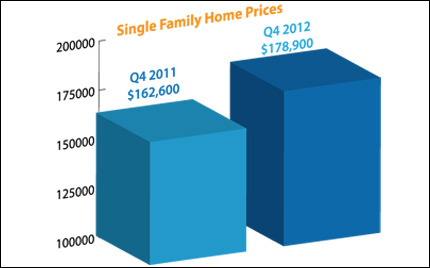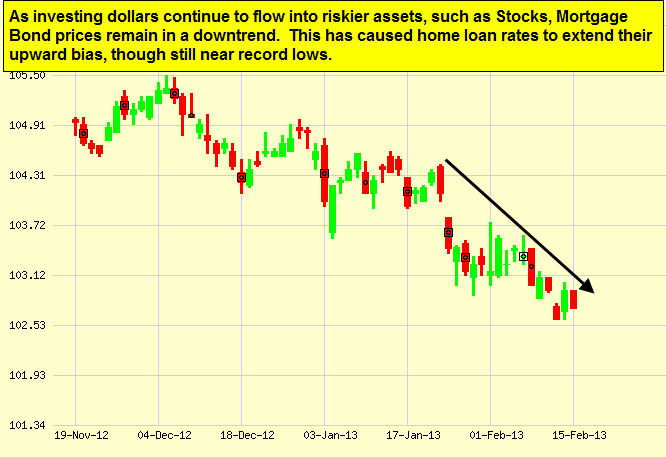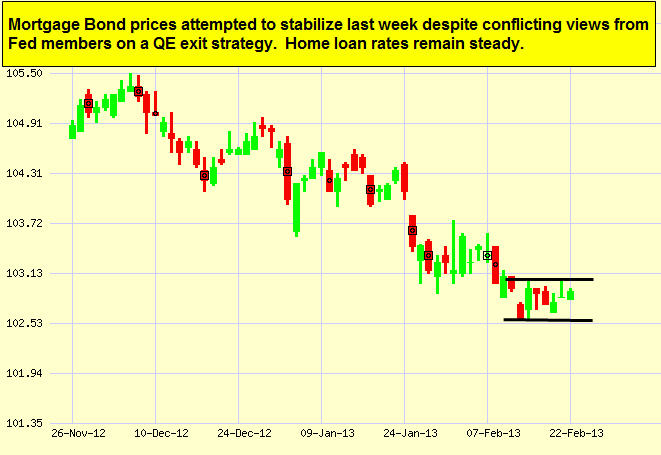|
|
|
Last Week in Review:
There was another sign that the housing market continues to recover. Plus,
chatter about the Fed.
Forecast for the Week: The markets are closed Monday for Presidents'
Day, but important housing and inflation news will be released later in the
week.
View: Thinking less may actually help you get more
done. Check out why below.
|
|
|
|
"Ease
on down the road." The song from the musical The
Wiz could also apply to recent chatter in the markets, regarding
whether the Fed will continue to "ease on" with their Bond buying
program, known as Quantitative Easing. Read on for details and what they
mean for home loan rates.
 Quantitative
Easing is the concept of the Fed becoming a buyer of Treasuries and Bonds
to try and stimulate the economy. Oftentimes, the Fed does Quantitative
Easing when they are hoping to (1) create inflation and avoid a
deflationary economy, (2) lower the unemployment rate, and (3) boost Stock
prices. Quantitative
Easing is the concept of the Fed becoming a buyer of Treasuries and Bonds
to try and stimulate the economy. Oftentimes, the Fed does Quantitative
Easing when they are hoping to (1) create inflation and avoid a
deflationary economy, (2) lower the unemployment rate, and (3) boost Stock
prices.
Over the last few months, the Fed has bought large amounts of Mortgage
Bonds through their Quantitative Easing program to keep home loan rates
(which are tied to Mortgage Bonds) near record lows, and to help strengthen
our housing market and economy overall. And the housing market has
definitely seen some improvement. Last week, the National Association of
Realtors reported that the national median existing single-family home
price surged 10% since this time last year to $178,900. The year-over-year
increase of 10% was the largest gain since the fourth quarter of 2005.
This is one of the big reasons the Fed will likely continue their
Quantitative Easing program: The housing market is on the mend and stopping
the program could threaten the housing recovery.
So what is the bottom line? Stocks continue to do well--at
the expense of Bonds and home loan rates. However, the debt crisis
continues in Europe: Spain, Italy and Greece remain in contracting
economies and now France and Germany have shown negative GDP growth that
was even worse than expected. This means that investors will likely
continue to see our Bond market as a safe haven for their money, which
could ultimately benefit Bonds--and home loan rates, which are tied to
Mortgage Bonds--in the process.
The biggest take away is that home loan rates remain near historic
lows, making now a great time to consider a home purchase or refinance. Let
me know if I can answer any questions at all for you or your clients.
|
|
|
|
|
Chart: Fannie Mae 3.0% Mortgage Bond (Friday Feb 15, 2013)
 The
markets are closed Monday in observance of the Presidents' Day holiday, but
look for several important reports later in the week. The
markets are closed Monday in observance of the Presidents' Day holiday, but
look for several important reports later in the week.
- Housing news hits the wires, with Housing Starts
and Building Permits on Wednesday and Existing Home Sales
on Thursday.
- We'll get a double dose of inflation news with
Wednesday's wholesale-measuring Producer Price Index, followed
by the Consumer Price Index on Thursday.
- Also on Thursday, Initial Jobless Claims and
the Philadelphia Fed Index will be reported.
In addition, the
minutes from the January meeting of the Federal Open Market Committee will
be released on Wednesday at 2:00pm ET. With all the differing opinions of
the Fed governors and the chatter about Quantitative Easing, this has the
potential to move the markets.
Remember: Weak economic news normally causes money to flow out of Stocks
and into Bonds, helping Bonds and home loan rates improve, while strong
economic news normally has the opposite result. The chart below shows
Mortgage Backed Securities (MBS), which are the type of Bond that home loan
rates are based on.
When you see these Bond prices moving higher, it means home loan
rates are improving -- and when they are moving lower, home loan rates are
getting worse.
To go one step further -- a red "candle" means that MBS worsened
during the day, while a green "candle" means MBS improved during
the day. Depending on how dramatic the changes were on any given day, this
can cause rate changes throughout the day, as well as on the rate sheets we
start with each morning.
As you can see in the chart below, Bonds and home loan rates have been
impacted by the rally in Stocks. However, home loan rates remain near
record lows and I'll continue to monitor them closely.
|
|
|
|
The Mortgage
Market Guide View...
|
|
|
|
|
|
Rituals of Success
How to Get More Done By Thinking Less
If you've ever felt like you can't find time to get to your list of
important things, you're not alone. New York Times best selling
author Tony Schwarz says almost 75 percent of workers around the world feel
disengaged at work and that the "more, bigger, faster" mantra is
to blame. We are busier than ever, trying to get more done with fewer
resources.
Schwarz suggests everything we do--whether checking email, exercising, or
resisting the temptation to eat an extra cookie--often requires thinking,
and thinking takes energy. So, if you want to get more done you must
actually think less.
In 1911, philosopher A.N. Whitehead wrote: "It is a profoundly
erroneous truism that we should cultivate the habit of thinking of what we
are doing. The precise opposite is the case. Civilization advances by
extending the number of operations we can perform without thinking
about them."
The answer, according to Schwarz, is to make important things automatic,
what he calls a ritual. Rituals are highly specific behaviors performed
at a specific time. He reports the five rituals that have made the most
difference in his life are:
- Sticking to a bedtime that ensures he gets at least
8 hours of rest.
- Working out first thing in the morning, whether he
feels like it or not.
- Starting his workday by doing the most important
task first--decided the night before--and working only in 90-minute
time blocks with a definite break in between.
- Writing down his good ideas immediately, so they
aren't bouncing around in his mind all day, or worse, forgotten
entirely.
- When upset by someone or something, he ritually
asks how he can see the same set of facts in a more hopeful or
empowering way.
Remember, the less you
have to think about your goals as you perform the steps to achieve them,
the more likely you are to check them off your list.
Economic
Calendar for the Week of February 18 - February 22
|
Date
|
ET
|
Economic Report
|
For
|
Estimate
|
Actual
|
Prior
|
Impact
|
|
Wed. February 20
|
08:30
|
Housing Starts
|
Jan
|
910K
|
|
954K
|
Moderate
|
|
Wed. February 20
|
02:00
|
FOMC Minutes
|
1/30
|
NA
|
|
NA
|
HIGH
|
|
Wed. February 20
|
08:30
|
Core Producer
Price Index (PPI)
|
Jan
|
0.1%
|
|
0.1%
|
Moderate
|
|
Wed. February 20
|
08:30
|
Producer Price
Index (PPI)
|
Jan
|
0.3%
|
|
-0.2%
|
Moderate
|
|
Wed. February 20
|
08:30
|
Building Permits
|
Jan
|
918K
|
|
903K
|
Moderate
|
|
Thu. February 21
|
08:30
|
Jobless Claims
(Initial)
|
2/16
|
358K
|
|
341K
|
Moderate
|
|
Thu. February 21
|
08:30
|
Core Consumer
Price Index (CPI)
|
Jan
|
0.2%
|
|
0.1%
|
HIGH
|
|
Thu. February 21
|
10:00
|
Existing Home
Sales
|
Jan
|
4.94M
|
|
4.94M
|
Moderate
|
|
Thu. February 21
|
10:00
|
Philadelphia Fed
Index
|
Feb
|
1.5
|
|
-5.8
|
HIGH
|
|
Thu. February 21
|
08:30
|
Consumer Price
Index (CPI)
|
Jan
|
0.1%
|
|
0.0%
|
HIGH
|
|
|
|
|
The material
contained in this newsletter is provided by a third party to real estate,
financial services and other professionals only for their use and the use
of their clients. The material provided is for informational and
educational purposes only and should not be construed as investment and/or
mortgage advice. Although the material is deemed to be accurate and
reliable, we do not make any representations as to its accuracy or
completeness and as a result, there is no guarantee it is without errors.
As your mortgage
professional, I am sending you the MMG WEEKLY because I am committed
to keeping you updated on the economic events that impact interest rates
and how they may affect you.
is the copyright
owner or licensee of the content and/or information in this email, unless
otherwise indicated. does not grant to you a license to any content,
features or materials in this email. You may not distribute,
download, or save a copy of any of the content or screens except as
otherwise provided in our Terms and Conditions of Membership, for any
purpose.
|
|







